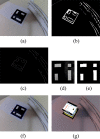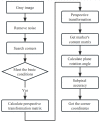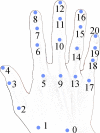ARIAS: An AR-based interactive advertising system
- PMID: 37773972
- PMCID: PMC10540975
- DOI: 10.1371/journal.pone.0285838
ARIAS: An AR-based interactive advertising system
Abstract
In this paper, we present an interactive advertising system based on augmented reality(AR) called ARIAS, which is manipulated with gestures for displaying advertising videos. Two-dimensional markers are defined in the system. The system captures the frame data through the camera in real time, uses OpenCV library to identify the predefined markers, and calculates the pose of markers captured by the camera. With OpenGL library, a virtual cubic model is created at the position of the marker, and thus videos or images are displayed on the six faces of the cube. The virtual cube, together with the original frame data collected by the camera, is displayed in the interactive window to achieve the augmented reality effect. Customers are accessible to various advertising content by observing the marker from different positions. The system, meanwhile, supports gesture operation in order to make the customers pay attention to the content they are interested in with one hand. The MediaPipe Hand framework is used to extract the landmarks of hands, based on which, a series of gestures are designed for interactive operation. The efficiency and accuracy of the system are tested and analyzed with the result, indicating that the system has high reliability and good interactiveness. This system is open at https://github.com/wanzhuxie/ARIAS/tree/PLOS-ONE.
Copyright: © 2023 Wang, Xie. This is an open access article distributed under the terms of the Creative Commons Attribution License, which permits unrestricted use, distribution, and reproduction in any medium, provided the original author and source are credited.
Conflict of interest statement
The authors have declared that no competing interests exist.
Figures















References
-
- Masneri S, Dominguez A, Sanz M, Tamayo I, Zorrilla M, Larranaga M, et al. Collaborative Multi-user Augmented Reality Solutions in the Classroom. MOBILITY FOR SMART CITIES AND REGIONAL DEVELOPMENT—CHALLENGES FOR HIGHER EDUCATION (ICL2021), VOL 2. 2022;390:1004–11.
-
- Blas Padilla D, Vazquez-Cano E, Morales Cevallosi MB, Lopez Meneses E. Use of augmented reality apps in University classrooms. CAMPUS VIRTUALES. 2019;8(1):37–48.
-
- Trujano F, Khan M, Maes P. ARPiano Efficient Music Learning Using Augmented Reality. INNOVATIVE TECHNOLOGIES AND LEARNING, ICITL 2018. 2018;11003:3–17.
-
- Amaya Cote LP, Santoyo Diaz JS. EVALUATION OF MUSIC EDUCATION USING AUGMENTED REALITY. CUADERNOS DE MUSICA ARTES VISUALES Y ARTES ESCENICAS. 2017;12(1):143–57. Spanish.
-
- Yulianti Y, Wardhani LK, Hakim AR, Aji SD, Hudha MN. Augmented Reality (AR) subject Natural Science media for human framework topics. 5TH ANNUAL APPLIED SCIENCE AND ENGINEERING CONFERENCE (AASEC 2020). 2021;1098(032032).
MeSH terms
LinkOut - more resources
Full Text Sources
Research Materials

